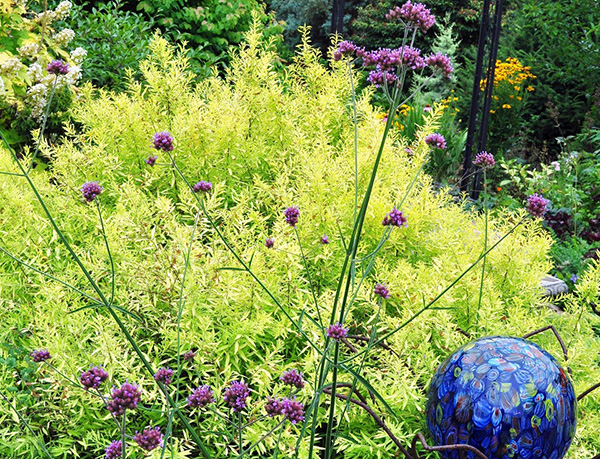UT Gardens June 2013 Plant of the Month: Ogon spirea
Ogon spirea makes a brilliant contrast against plants with bold leaves or plants with purple or bronze foliage

The bright foliage of Ogon spirea provides a perfect backdrop for the violet tops of tall verbena (Verbena bonariensis) in this private landscape. A healthy specimen can also be found on the north border of the parking lot at UT Gardens on the grounds of the West Tennessee AgResearch and Education Center in Jackson. See it at the Summer Celebration, July 11. Photo by C. Reese.
If you live in an older neighborhood, you are likely to find a Thunberg spirea somewhere on your street, perhaps in your own yard. It is one of those plants so durable that it is likely to outlive the person that planted it, or even the home itself.
It is usually the first of the spirea species to flower in spring. The curving delicate branches will be covered with small white flowers that are unfazed by frost. Except for the interest found in the fine wispy foliage, it offers little more in the landscape until fall, when the foliage is diffused with soft peach and orange hues. That is, unless you plant the cultivar ‘Ogon’, now sometimes sold under the trademarked name Mellow Yellow. Now we are talking about a plant that offers very early spring bloom, gorgeous golden foliage throughout the summer and lingering fall color.
While many shrubs stand stiffly in the landscape, Ogon spirea moves softly in the breeze, adding a diaphanous quality in direct contradiction to its sturdy constitution. It makes a brilliant contrast against plants with bold leaves, or even better, with plants of purple or bronze foliage.
Hardy in zones 4 – 8, this plant performs best in full sun. Part shade will work, but the golden color will dim in response to shade. It prospers in any soil except overly wet and will form a somewhat weeping mass about 5 feet wide and 4 feet tall.
Carol Reese is the Western Region Ornamental Horticulture Specialist for University of Tennessee Extension. Her office is located in the West Tennessee AgResearch and Education Center in Jackson. The UT Gardens include plant collections located in Knoxville, Jackson and Crossville. Designated as the official botanical garden for the State of Tennessee, the collections are part of the University of Tennessee Institute of Agriculture. Their mission is to foster appreciation, education and stewardship of plants through garden displays, educational programs and research trials. The gardens are open during all seasons and free to the public. See
http://utgardens.tennessee.edu for more information.
Source: Submitted by Carol Reese, UT Extension horticulture specialist, Western Region











